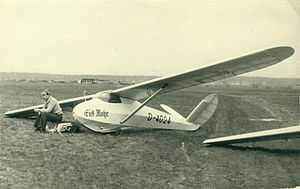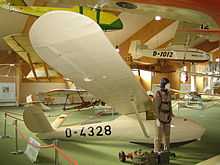Schleicher Ka 3
| Ka 3 | |
|---|---|
 | |
| Prototype Ka 3 in 1954 | |
| Role | Single seat training glider |
| National origin | Germany |
| Manufacturer | Alexander Schleicher Segelflugzeugbau |
| Designer | Rudolf Kaiser |
| First flight | 1954 |
| Number built | 15 |
|
| |
The Schleicher Ka 3 or Kaiser Ka 3, is a 1950s single seat training glider, mostly sold in kit form.
Design and development
The Ka 3 and its predecessor the Ka 1 were mostly sold as kits for home assembly. Apart from their fuselages the two types are very close in appearance, simplicity, weight and performance. They share a round tipped high wing with constant chord and no sweep, mounted with 2.5° of dihedral and braced with a single lift strut on each side from the lower fuselage to the wing at about one third span. Plain, constant-chord ailerons reach almost from the tips to about mid span and upper wing spoilers are placed at mid chord, inboard of the ailerons. Both have 37° butterfly tails with straight leading edges and round tips and trailing edges.[1]
The Ka 1 has a ply-covered, rounded wooden-framed fuselage but that of the Ka 3 is more angular, steel tube-framed, fabric covered and slightly longer. Both have a simple, deep, sprung landing skid reaching from the nose to under the trailing edge of the wing, assisted by a tail bumper. Their cockpits are under the wing leading edge, into which the clear canopy extends.[1]
The Ka 1 first flew in 1951 and ten were built;[2] the Ka 3 followed in 1954 with fifteen eventually completed.[1] One Ka 1 and two Ka 3s remained on the German civil aircraft register in 2010.[3]
Variants


- Ka 1 Rhönlaus
- Original version with rounded, wooden fuselage.[1] First flown 1951. 10 built.[2]
- Ka 3
- Development with a slightly longer, fabric-covered steel-tube fuselage. Performance and weights as Ka 1. First flown in 1954. 15 produced.[1]
Specifications (Ka 3)
Data from The World's Sailplanes pp.83-5[1]
General characteristics
- Crew: One
- Length: 5.45 m (17 ft 11 in)
- Wingspan: 10.00 m (32 ft 10 in)
- Wing area: 9.9 m2 (107 sq ft)
- Aspect ratio: 10.1
- Airfoil: Göttingen 549
- Empty weight: 100 kg (220 lb) equipped
- Max takeoff weight: 195 kg (430 lb)
- Wing loading: 19.5 kg/m2 (5.2 lb/sq ft) maximum
Performance
- Maximum speed: 160 km/h (99 mph; 86 kn) placard, smooth air. All performance figures at a flying weight of 180 kg (397 lb)
- Maximumun speed, placard, rough air: 100 km/h (62 mph; 54 kn)
- Maximumun aero-tow speed: 100 km/h (62 mph; 54 kn)
- Maximumun winch launch speed: 90 km/h (56 mph; 49 kn)
- Stall speed: 53 km/h (33 mph; 29 kn)
- Maximum glide ratio: best, 17.5:1 at 75 km/h (47 mph; 40 kn)
- Rate of sink: 1.0 m/s (200 ft/min) at 65 km/h (40 mph; 35 kn)
References
- ↑ 1.0 1.1 1.2 1.3 1.4 1.5 Wilkinson, K.G.; Brooks, Peter; Shenstone, B.S. (1958). The World's Sailplanes - Die Segelflugzeuge der Welt - Les Planeurs de le Monde (in English and German and French) I. Organisation Scientifique et Technique International de Vol à Voile (OSTIV) & Schweizer Aero-Revue. pp. 81, 83–5146–9.
- ↑ 2.0 2.1 "Kaiser Ka 1". Retrieved 17 November 2012.
- ↑ Partington, Dave (2010). European registers handbook 2010. Air Britain (Historians) Ltd. ISBN 978-0-85130-425-0.
| ||||||||||||||||||||||||||
| ||||||||||||||||||||||